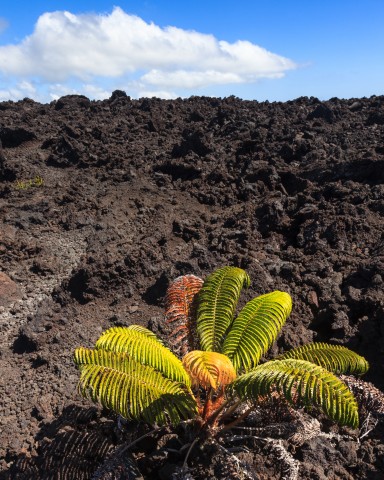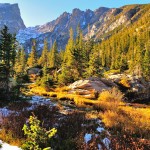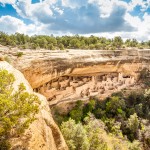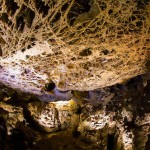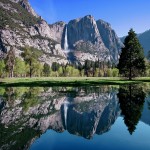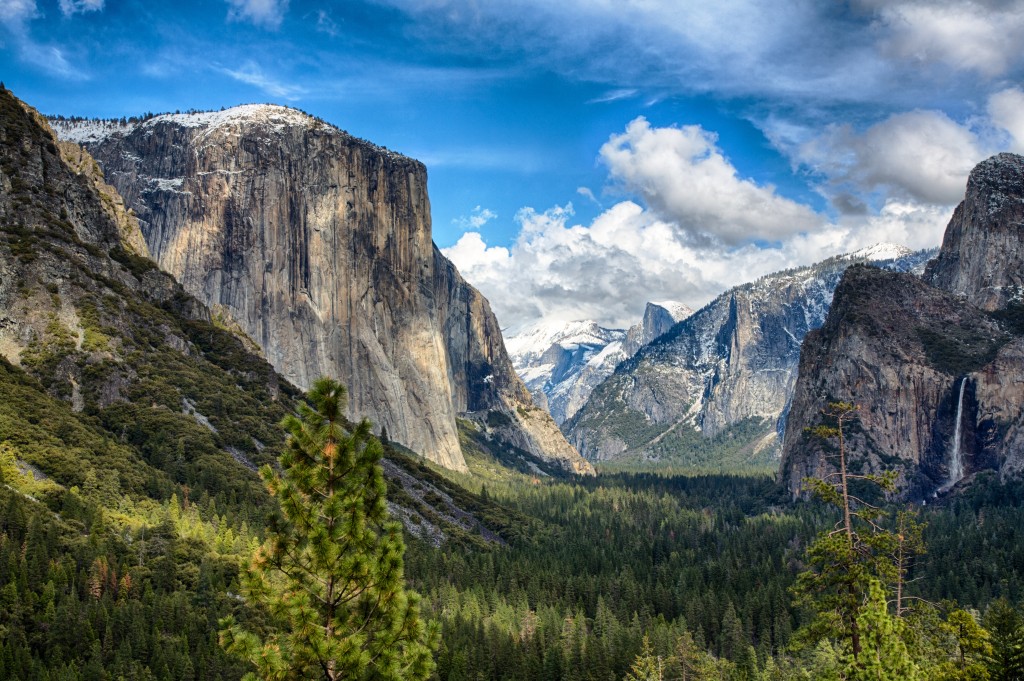Profile of Haleakalā and Hawaii Volcanoes National Park
Haleakalā (Hawaiian for "The House of the Sun") National Park is 33,265 acres of protected area in the Hawaiian islands, over 28,000 acres are designated wilderness. Amongst the smallest of the US National Parks, this delicate volcanic area is located on the Hawaiian island of Maui and once incorporated the volcanoes but today is a separate national park in its own right (1). In contrast, Hawaii Volcanoes National Park is over 300,000 acres (2) of land on the main island of Hawaii. It incorporates the world famous volcanoes Kīlauea and Mauna Loa.
Together, they are one of UNESCO’s Biosphere Reserves thanks to the diverse landscape that includes volcanic upland, alpine hillside, desert scrub and Pacific coastal ecology across both parks. Hawaii Volcanoes National Park specifically is a designated World Heritage Site (3). Signed into law in 1916 as a single National Park called Hawaii National Park, in 1960 they were separated to create the two parks we know today. Haleakalā has one volcano whereas its larger cousin incorporates a larger area and more volcanic landscape including several iconic geologic formations.
A Brief History of Haleakalā
It is understood that the Hawaiian islands are very young, with the eldest calculated to be around 6m years old and the youngest around 1m years old – a mere sliver of time in comparison to some of our other natural protected landscapes. It’s understood that the changes to the plates that would lead to the formation of the islands began about 40m years ago (4). Human settlement also came surprisingly late, with archaeological evidence suggesting the Hawaiian people arrived not more than 1000 years ago (5, p3-5). The islands were very sacred to the ancient people who lived there, particularly Kīlauea which is said to be home to the volcano goddess Pele (6). The gentle slopes of the mountain meant that ancestors of the modern Hawaiians were able to get close to the crater of Kīlauea – a volcano which has undergone near continuous eruption for some 30 years (3).
The land now within Haleakalā National Park contains a volcano which is understood to have erupted some time between 1480 and 1600. The 6.9 mile wide crater dominates the landscape and is a great place to watch the sunrise, something that perhaps adds to the spiritual element of the indigenous population and drew European explorers in earlier times. As Polynesians were late arriving, so were western visitors. It is understood that the first white people to visit the Hawaiian Islands were British explorer James Cook in the late 18th century; Mass migration did not begin until after 1823 when missionaries William Ellis and Asa Thurston visited to marvel at the boiling lakes of lava (6). Around the time of Cook’s arrival, a number of indigenous people visited the volcano of Kīlauea, were caught in an eruption and killed. Today, their footprints are preserved in the volcanic rock and one of the area’s finest archaeological conservation monuments (7).
Calls to preserve the volcanic and natural landscape began in the early part of the 20th century with Lorrin Thurston who recognized the importance of preserving the volcanic landscape for cultural as well as environmental reasons. He began proceedings to have it protected in 1906; it took ten years but finally in 1916, what was then Hawaiian Volcanoes National Park was signed into law by Woodrow Wilson. Initially, it only protected the two most famous summits (Kilauea and Mauna Loa) and only later were more of the geologic features added (6). The old park was reorganized in 1960 when Haleakalā became its own, much smaller National Park leaving the NPS to protect the larger volcanic area as a separate property. International recognition came in 1980 when UNESCO designated both parks as an International Biosphere Reserve in 1980, and Hawaii Volcanoes National Park became a World Heritage Site later the same decade (3).
The Flora of Haleakalā & Hawaii Volcanoes National Park
Both parks are home to some impressive native species of plant that evolved on the harsh slopes of the volcanic islands, in its lush rainforests and along the threads of the islands coasts. Despite their ecological similarities, surprisingly both parks have plant life that appear only within their designated protected areas – thanks to the severe landscapes.
It is understood that none of the plants present at Haleakalā evolved there; the islands are simply too young, yet hundreds or thousands of years of adaptation creating many niche species which are now an important part of the ecology (8). Most would have had their pollen or seeds either swept across along the trade winds from other islands or the mainland, or have been specifically brought there by the earliest settlers. It has been demonstrated that when introduced to a new environment, plant and animal species can adapt, evolve and change quickly due to the island effect (9). Such an effect would be clearly identifiable in the natural labs of the Hawaiian Islands when we know that not a single specimen could have evolved there.
The parks are home to a species known as silversword – with both parks having their own distinct species (8, 10). The only difference is in the breadth of the individual leaves (Mauna Kea also has its own subspecies). They are a hardy plant, growing in the harsh volcanic environment of the islands and thriving in hot, dry climates and they are presently subject to several threats that require conservation efforts.
The Hawaiian Islands are home to some unusual and wonderful plant species. The pilo (related to the coffee plant) makes its home on the arid desert areas (11) and the Ha`i wale (12), an adapted form of the African violet, lives along the coastal strands right across the islands. Most of the islands’ endemic species are adapted from other species elsewhere across the Pacific or Asian subcontinent.
Plant Conservation Issues
Haleakalā Silversword and Mauna Loa Silversword mentioned above are both threatened by the same set of circumstances. Once, it was visitors to the volcanic landscape ripping up specimens to put in their homes but today – the once covered caps of the volcanos which looked white because of the abundance of the plant, now look thin in comparison (8, 10). The picture at Haleakalā is especially concerning as the introduction of ungulates and non-native animals have made the picture even more fragile. National Park Service workers have fenced off delicate areas and routinely remove invasive species (13) that have been in danger of crowding out the silverswords. A systematic program that saw many years of growing and nurturing of seedlings in greenhouses means there is hope for the rejuvenation of this popular and iconic plant (14).
Despite the plant’s hardiness, climate change may yet prove the undoing of efforts to encourage it to spread across the islands once more. NPS researchers have already recorded lower precipitation and higher temperatures on the marginal slopes where the silversword grows (13). Climate change induced drought is not just a threat, but a reality. The potential knock-on effects could be enormous for plant, animal and human life on the islands.
Endemic to the Haleakalā Crater, the Haleakalā schiedea (15) has been considerably reduced and only between 100 and 200 specimens are now known to exist. The major threat to this plant is the islands goat population. As most people known, goats will eat almost anything and roam wild in most places. Fencing efforts are so far proving effective and it is believed that a substantial recovery could be expected in the coming years. In fact, invasive animals represent the biggest single threat to both Haleakalā and Hawaiian Volcanoes National Park (16) with goats, pigs and even non-native mosquitos causing most of the recorded damage. The bitter irony is that invasive species is the reason for the unique make-up of the islands’ ecology in the first place.
Most of the endemic plants of the island are threatened are endangered – UNESCO report 40 of 41 recorded plants (21) are listed with protected status, indicating the delicate nature of the archipelago.
The Fauna of Haleakalā
The nature of island wildlife, especially an archipelago, is very heavily favored towards birds and both parks have an abundance of attractive an interesting species that live across the diverse and varied ecosystems. The Hawaiian Petrel is an iconic bird and is one of the species presently under threat (17, p1); even more unusual and also a protected species are the native honeycreepers – an unusual subspecies of bird which is represented by many different types of the island (18). They live across the islands and in both parks but their primary breeding ground is the crater of Haleakalā but they are also found on Mauna Loa and Maui.
Another icon of the Hawaiian Islands, and one known to make its home within the beaches of Volcanoes National Park, are the various types of turtle. Hawaii has always provided a sanctuary for the various species, but today many are threatened. The hawksbill is a known resident of the islands but has become critically endangered that strict guidelines are in place to protect the species (19). In contrast, the green turtle has seen a reverse of its global trend – there is more information below.
Curiously, the Hawaiian islands in general are noticeably absent of native mammal species except for a single species of bat – the Hawaiian hoary (21). All other mammals have been introduced since the arrival of human settlers since approximately the early 19th century which include typical livestock such as goats and pigs. None of these are native and can be, in some cases, part of the problem.
Fauna Conservation Issues
As mentioned above, the Hawaiian Petrel is of grave concern (17, p1) and it is Federally listed as an endangered species – as is the honeycreeper also mentioned (18). The major threat to its habitat is ruminants such as pigs and goats (17, p2). Just as the NPS is fencing off areas to protect delicate plants such as the silverswords, encroachment by semi-wild animals and livestock is also a threat to other animals – native and other precarious populations. A growth in predation has also been cited as a factor for their decline and a reason to continue their protected status.
The hawksbill is protected and several threats exist including poaching (their shells are attractive and sold illegally as decorations across the world) (19). This is not the only threat, loss of habitat and an increase in predation - some introduced species as well as conditions being favorable to other species – have also taken their toll on this and many other species of turtle. It’s not all bad news though, Hawaii has reported increased population of another type of turtle, the green turtle, and it is one that is declining globally. Conservation efforts in Hawaii have improved the situation for the species which has now been sustained and improved for some 25 years (20).
Between 1970 and 1988, the islands’ only native mammal species (the hoary bat) underwent significant protection and promotion and was Federally listed as endangered. It has been recorded on the major islands and within the two National Parks discussed here. The Federal conservation program was lifted then, but several identified threats were noted at the time (22) and it is subject to persistent monitoring and management of native habitats to promote bat populations in line with national and international conservation and relief efforts.
Ongoing Conservation Challenges of Haleakalā & Hawaii Volcanoes National Park
The Hawaiian Islands are an unusual case study because the nature of the islands means that there are no native species. Every endemic animal and plant species on the island has arrived in a relatively recent timeframe brought by winds from the major continents or by migratory birds (seeds of plants carried by wind or ocean, and small insects for example). Both parks and the islands in general have always been a frontier for new arriving species – this cannot be avoided and will always be the case; most do not survive but sometimes they take root and adapt leading to the island effect and speciation (23). By definition, invasive species are both a major threat to these parks and the very reason for the ecology’s diversity in the first place. National Park Service survey for this along with general conservation efforts and understanding how they exist in the first place.
Human settlement has brought new pressures in the form of farming – and this began long before the arrival of European and modern American settlers. There is archaeological evidence that forests were burned with the earliest human arrivals and the land was never permitted to recover (23). This problem continued with the planting of sugar and other rich crops during the 18th and 19th centuries for the Pacific sea trade in luxury goods. Now the parks have a livestock problem – note the extensive issues caused by goats and pigs on the island which threaten not just the delicate plants, but also pose a threat to birds in competing for breeding and feeding grounds.
Finally, and once again, we have the issue of climate change. We are already seeing a measurable drop in precipitation. Couple that with temperature increases, and you have the risk of desertification of some already marginal areas within the parks. The desert areas are likely to grow and encroach on the forests, putting many already threatened species at risk – it is important to remember that 40 of 41 native species on the islands are protected in some form (21).
Sources
(1) https://irma.nps.gov/Stats/Reports/National
(2) http://www.nps.gov/havo/learn/management/world_heritage_site.htm
(3) https://www.soest.hawaii.edu/GG/HCV/haw_formation.html
(4) http://www.academia.edu/1034367/When_Did_the_Polynesians_Settle_Hawaii
(5) http://www.nps.gov/hale/learn/nature/plants.htm
(6) http://www.ncbi.nlm.nih.gov/pmc/articles/PMC1563487/
(7) http://www.nps.gov/havo/learn/nature/plants.htm
(8) http://www.nps.gov/hale/learn/nature/plant-communities.htm
(9) http://www.nps.gov/hale/learn/nature/upload/Kipahulu-Coastal-Strand.pdf
(10) http://www.nps.gov/hale/learn/nature/silversword.htm
(11) http://www.fws.gov/endangered/bulletin/2000/05-06/22-23.pdf
(12) http://explorer.natureserve.org/servlet/NatureServe?searchName=Schiedea+haleakalensis
(13) http://www.nps.gov/havo/learn/nature/environmentalfactors.htm
(14) http://www.nps.gov/hale/learn/news/upload/UauInformation-NPS.pdf
(15) http://www.nps.gov/hale/learn/nature/honeycreeper.htm
(16) http://www.fpir.noaa.gov/PRD/prd_green_sea_turtle.html
(17) http://whc.unesco.org/en/list/409
(18) http://www.fws.gov/pacificislands/fauna/HIhoarybat.html
(19) http://www.nps.gov/havo/learn/nature/onthebrink.htm






